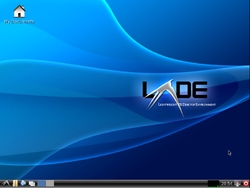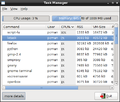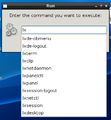LXDE: Difference between revisions
m robot Adding: ar:إل إكس دي إي |
Undid revision 271819944 by Thumperward (talk) |
||
| Line 37: | Line 37: | ||
==Development== |
==Development== |
||
LXDE is built in the [[C programming language]], using the [[GTK+]] toolkit, and runs on [[Unix]] and other [[POSIX]] compliant platforms, such as [[Linux]] and [[BSD]]. GTK+ is commonly used in many |
LXDE is built in the [[C programming language]], using the [[GTK+]] toolkit, and runs on [[Unix]] and other [[POSIX]] compliant platforms, such as [[Linux]] and [[BSD]]. GTK+ is commonly used in many GNU/Linux distributions and allows applications to run on different platforms. <ref>{{cite web|url=http://www.gtk.org/features.html|title=GTK+ Features}}</ref> |
||
===Components=== |
===Components=== |
||
Revision as of 21:39, 20 February 2009
This article needs additional citations for verification. (September 2008) |
 | |
 A screenshot of LXDE | |
| Developer(s) | The LXDE Team |
|---|---|
| Initial release | 2006 |
| Preview release | 0.3.2.1
/ April 20, 2008 |
| Repository | |
| Written in | C, GTK+ |
| Platform | Cross-platform (Linux, BSD) |
| Available in | Multilingual |
| Type | Desktop environment |
| License | GNU General Public License, LGPL |
| Website | www.lxde.org |
LXDE is a free and open source desktop environment for Unix and other POSIX compliant platforms, such as Linux or BSD. The name LXDE stands for "Lightweight X11 Desktop Environment".[1][2]
LXDE is designed to work well with computers on the low end of the performance spectrum such as the new generation netbooks and other small computers. LXDE is energy efficient and fast compared to other desktops.[3][4] LXDE can be built on top of various Linux distributions such as Ubuntu or Debian.
History and community
The project was started in 2006 by Taiwanese hacker Hong Jen Yee, also known as PCMan, when he published PCManFM, a new file manager and the first module of LXDE.
Goals of the LXDE project
The LXDE project aims include:
- a desktop environment which is fast and saves energy
- keep the resource usage low, including low RAM, low CPU and low disk space usage.
- full featured desktop
- multilanguage support
Development
LXDE is built in the C programming language, using the GTK+ toolkit, and runs on Unix and other POSIX compliant platforms, such as Linux and BSD. GTK+ is commonly used in many GNU/Linux distributions and allows applications to run on different platforms. [5]
Components
Unlike in other desktop environments, the components of LXDE are not tightly integrated.[6] Instead, they can run independently of each other.[7]
LXDE consists of several components:
- PCMan File Manager
- LXLauncher, easy-mode application launcher
- LXPanel, desktop panel
- LXSession, session manager
- LXAppearance, theme switcher
- leafpad, text editor
- Xarchiver, archiving
- GPicView, image viewer
- LXTerminal, terminal emulator
- LXTask, task manager
- LXNM, lightweight network connection helper daemon for LXDE supporting wireless connections (Linux-only)
- Openbox, window manager
Release cycle
There are currently only development versions and no stable versions of LXDE.
Licensing
LXDE includes GPL licensed code as well as LGPL licensed code.[1]
Hardware compatibility
Computer processor architectures supported by LXDE currently include x86, x86-64, and MIPS.
Distributions including LXDE
- Arch Linux [8]
- Debian 5.0 "Lenny" [9]
- Fedora 10[10]
- Gentoo Linux[11]
- gOS 3.0 [12]
- Greenie Linux: Ubuntu-based OS with LXDE and GNOME desktop environments[13]
- Hiweed 2.0RC: Ubuntu derivative tailored for Chinese-language users.[citation needed]
- Knoppix 6.0: Debian based Live-CD featuring LXDE as the default Desktop Environment as of version 6.0.[14]
- lxde-sid-lite: An unofficial sidux based Live-CD with LXDE, Harddisk and USB installer, special tailored for netbooks like the Eee PC.[15]
- Mandriva Linux 2009 supports LXDE and can be installed after system installation.[16]
- Mandriva Linux 2009.1 (alias Spring) will support LXDE as the default light environment.[17]
- Myah OS 3.0 Box edition: LXDE flavor of Myah OS.[citation needed]
- Parted Magic 3.1, A partition tool now based on LXDE[1]
- PUD GNU/Linux: Ubuntu-based installable live cd with LXDE[18]
- Ubuntu 8.10 "Intrepid Ibex" includes LXDE in its repositories, LXDE can also be installed in earlier versions of Ubuntu[19]
- U-lite[20][21]
- VectorLinux Light[citation needed]
LXDE gallery
-
LXDE Picture Viewer
-
LXappearance
-
LXpanel
-
LXpanel Preferences
-
LXtask
-
PCManFM
-
PCManFM
-
Autocompletion of Panel tasks
References
- ^ a b c LXDE Team (undated). "LXDE". Retrieved 2008-10-26.
{{cite web}}: Check date values in:|year=(help)CS1 maint: year (link) - ^ LXDE Team (undated). "About LXDE". Retrieved 2008-11-01.
{{cite web}}: Check date values in:|year=(help)CS1 maint: year (link) - ^ Todd Ogasawara. "LXDE may let netbooks run even faster". Retrieved 2008-08-08.
- ^ Eric Brown. "Lightweight GNOME alternative emerges". Retrieved 2008-08-07.
- ^ "GTK+ Features".
- ^ Łukasz Bigo. "LXDE - lekka alternatywa do GNOME". Retrieved 2008-08-08.
- ^ About LXDE
- ^ "LXDE in Arch's AUR". Arch Linux. Retrieved 2008-12-10.
- ^ "Details of package lxde in lenny". Debian Project. Retrieved 2008-10-13.
- ^ "Features/LXDE". Fedora Project. 2008-10-31. Retrieved 2008-11-08.
- ^ Gentoo Foundation (2008). "Gentoo LXDE Project". Retrieved 2008-11-29.
- ^ "gOS 3.0 goes Gadget crazy". DesktopLinux.com. Retrieved 2008-10-20.
- ^ "Greenie Operating System Website". Retrieved 2008-09-05.
- ^ "KNOPPIX 6.0 / ADRIANE 1.1 - Live CD". Retrieved 2009-01-29.
- ^ "lxde-sid-lite Linux resource saving and functional".
- ^ "Mandriva 2009 tour".
- ^ "Mandriva 2009.1 Alpha 2 with LXDE".
- ^ Distrowatch. "Development Release: PUD GNU/Linux 0.4.8.6 LXDE Edition". Retrieved 2008-04-05.
- ^ LXDE Wiki (2008). "Ubuntu". Retrieved 2008-12-03.
{{cite web}}: Unknown parameter|month=ignored (help) - ^ Scott Gilbertson. "Lightweight Linux Desktop Proves Popular with Netbooks". Retrieved 2008-08-07.
- ^ eWeek DesktopLinux.com, Henry Kingman. ""UbuntuLite" reviewed". Retrieved 2008-08-27.








